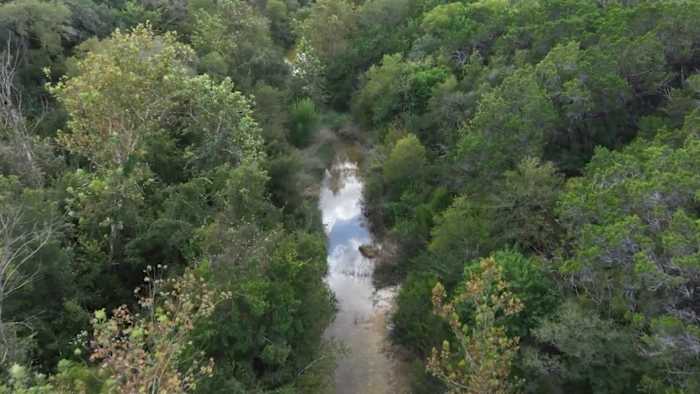SAN ANTONIO – San Antonio gets its drinking water from the Edwards Aquifer, it’s a karst or limestone system.
A Karst or limestone system is an area where the rock is dissolved by water and fractures keep getting larger and larger to put water into the aquifer.
It’s an underground system that makes up our Helotes Creek watershed as well as the Edwards and Trinity aquifers.
Guajolote Ranch is the proposed development that would create approximately 3,000 homes on 1,100 acres, just north of Grey Forest in northwest Bexar County.
The development, which would be built by Lennar Corporation, requires a wastewater treatment plant. The plant would treat and process sewage before dumping it into the Helotes Creek watershed, which feeds into the Edwards and Trinity aquifers.
Both are sources of drinking water for approximately 2.5 million people.
Take a look at drone footage of the Helotes Creek watershed below:
Some researchers and neighbors have been fighting the development for years.
Dr. George Veni, the former Executive Director of the National Cave and Karst Research Institute in Carlsbad, New Mexico, is an expert on karst systems.
Referring to an incident in Canada, Veni said any contaminant in a karst system can be deadly.
He points to an incident in Canada where this happened, and lots of people got sick and some even died.
“A farmer spread manure on his field, which is a typical thing to do, but then it was a perfect storm of things that went wrong,” Veni said. “He spread the manure, then it rained really hard, which pushed all of the bacteria from the manure more quickly down into the groundwater system before the bacteria has a chance to die off. And the bacteria reached a well. The chlorinator on the well failed. And so, that caught the attention of people.”
As a result, Veni said seven people died and approximately 2,300 more fell ill.
Limestone can be less predictable, with water flowing through cracks, fractures, holes. Some of those cracks and fractures can be as small as a finger or as big as a cave.
In 2010, Veni participated in a study examining karst systems near Loop 1604 and Blanco Road. The study involved taking non-toxic dyes and injecting them into caves and seeing where the dye went.
“And in one of the cases, we didn’t inject the dye into a cave because the cave is recognized as being a big conduit that’s gonna be right into the mainstream of the aquifer flow paths,” Veni said.
If the water flows into the Edwards Aquifer, it could contaminate the source for 15% of San Antonio’s drinking water and arrive in people’s wells within a matter of hours or days.
“The situation that happened in Canada is just telling us how sensitive the aquifer is to pollution and what the repercussions could be if the aquifers is polluted,” Veni said. “These aquifers are very sensitive. And so, whether it’s manure, whether it is chemicals, anything that’s gonna be bad for you — bacteria, heavy metals, oils and grease — you don’t want those in your drinking water supply.”
Bill Pack lives along Helotes Creek.
“When I heard about that report, it was pretty shocking,” Pack said. “I hadn’t heard of people dying before.”
He and his wife, Lisa Muyres-Pack, have been fighting the Guajolote Ranch development for years.
“If it gets contaminated, we are going to be threatened in probably several different ways,” Pack said. “No, it’s not a good feeling at all.”
Whatever happens with the proposed wastewater treatment facility, Veni said the safety of the community should Priority No. 1.
“I want to make sure that we understand how sensitive it is, and we need to have the proverbial seatbelt and airbag, you know, both working together, to protect our water supply,” Veni said.
In response to concerns about potential health and environmental risks associated with the project, a Lennar Corporation spokesperson issued the following statement to KSAT:
“Guajolote Ranch helps meet San Antonio’s critical need for more attainable housing. Lennar is taking extraordinary steps to protect water quality in the aquifer contributing zone with a wastewater treatment plan that meets all the requirements in the water service agreement with SAWS (San Antonio Water System) who will provide water to the community. Our facility will be among the most advanced of the area’s dozen or so treatment plants already operating over the contributing zone. We will be using membrane bioreactor technology operated by Class A-certified professionals so water is treated to the highest Type 1 standards and exceeds TCEQ (Texas Commission on Environmental Quality) requirements. That treated water will be safely reused on-site for irrigating community landscaping to reduce demand on freshwater and ensure a cleaner, safer system for the community.”
Lennar Corporation
More recent related coverage of this story on KSAT:
Copyright 2025 by KSAT – All rights reserved.
